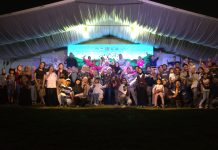After I was reminded twice by two different people – “If you have the chance, visit the Malaysian Chinese Museum,” I planned a stopover at the museum on my next trip to Kuala Lumpur.
Opened in 2018, this is the first museum in the nation which is preserving the history and current development of the Chinese Malaysian community.
[expander_maker id=”2″ more=”Read more” less=”Read less”]Read More
This museum was an initiative started in 2011 by the museum Chairman, Tan Sri Datuk Ng Teck Fong, who led a team in the Federation of Chinese Associations of Malaysia or Hua Zong, to gather relevant information and artefacts on the history of the Chinese from every state in West and East Malaysia.

I saw the Museum entrance, reached by an escalator on Level One when I was in Wisma Huazong for an event in October 2018 as a guest of Tan Chai Puan, my cultural activist friend, but did not have time to visit.
When I planned to visit this Museum, I informed Tan and he in turn, contacted his counterparts in the Museum to tell them about my visit.
At the ticketing counter, I collected a brochure which provided a brief introduction and guide to the 16 permanent exhibits that showcased some 1000 artefacts in this Museum.
As I was admiring the details designed in the Treasure Ship on which Admiral Cheng Ho sailed in his expeditions to the Western Seas, a Mr. Lim approached me with Tan Sri Datuk Ng, the Chairman of the Museum.
The Chairman was delighted that I had come all the way from Johor to visit the Museum and did not hesitate to escort me and paused at various points to share some interesting facts about the exhibits.
I couldn’t have asked for a better guide because the Chairman was also the Editorial Committee Chairman, who published a book on the Museum, entitled A Journey Through History: The Chinese and Nation-Building in Malaysia, which won the National Book Awards, Premier category in 2016.
The successful voyages by Admiral Cheng Ho in the 15th Century started an exodus of Chinese immigrants to the region of South East Asia, known to immigrants as Nanyang, which reached its peak between the end of the 19th Century and early 20th Century.
Their flight from China was mainly due to poverty, civil wars and famines as well as manpower resources imported by the British colonial government in Malaya and Singapore to meet the labour shortage in the tin and rubber industries.

After acquiring skills and wealth, some chose to return to China while most decided to settle in this new land to start a new life. It was interesting how the various Chinese dialect groups or clans settled down to live together in the various states.
I was impressed that Johor’s pepper and gambier heritage cultivated in the kangchu system was clearly preserved in the Museum, how the Chinese clans were united by the Johor Ruler, who provided them with land to build a common place of worship in the Johor Gu Miao or Old Temple, and even a common burial ground.
I like how the Chinese culture and traditions in worship, festivals, celebrations, trades, food and lifestyle were carefully preserved in the tableaus set up to portray old shops and businesses in busy street scenes at early settlements.
The dark era through World War Two, the Japanese Occupation and the birth of anti-government movements was also tastefully depicted.
In retaliation, the British government declared a National Emergency and forced the Chinese to be relocated into Kampung Baru or New Villages, confined in guarded enclosures under the watchful eyes of the British authorities.
This exhibit was both essential and educational for generations born after Independence to learn about the origins of our New Villages.
Meanwhile, I was happy to observe that out of the nine listed cultural traditions, three have their roots in Johor!
The Kun Seng Keng Lion Dance Troupe from Muar remains the undisputed Best of the Best in high-pole lion dance with an unrivalled number of wins in the bi-annual Genting World Lion Dance Championship.

The 24 Festive Drums’ unique art of drumming, co-founded by Tan Chai Puan and the late Tan Hooi Song in Johor Bahru in 1988, was recognised as a National Intangible Cultural Heritage in 2009.
In addition, the religious Parade of the Deities better known as the Johor Chingay, is an annual tradition of the Johor Gu Miao which has continued uninterrupted for generations except once during the Japanese invasion in World War Two.
This pulsating parade has since developed into a major tourist attraction and was honoured as the Best Domestic Event in the 2009 Johor Tourism Awards and recognised as a National Cultural Heritage in 2012.
Visiting this Museum was like taking a step back in history and I particularly enjoyed seeing the miniature figurines that depicted various scenes in history.
I was impressed by the Museum layout and contents and must say it is certainly worth a visit for a better understanding of the Chinese community here.
I gratefully accepted the Chairman’s gift of the book, A Journey Through History: The Chinese and Nation-Building in Malaysia and was happy to reciprocate by presenting him with my books, My Johor Stories: True Tales, Real People, Rich Heritage and My Johor Stories 2: Interesting Places and Inspirational People.
After this interesting and informative visit, it is my turn to say, “If you have the chance, visit this Museum!”
The Malaysian Chinese Museum is at Level One of Wisma Huazong, Lot 15285, 0.7km Lebuhraya Sungai Besi, 43300 Seri Kembangan, Selangor Darul Ehsan.
Open daily from 9.30am to 5pm. Ticket prices for adults is RM20, seniors aged 65+ and disabled RM10, and children aged 4 to 6 and students with valid student identities RM5 only.
[/expander_maker]



